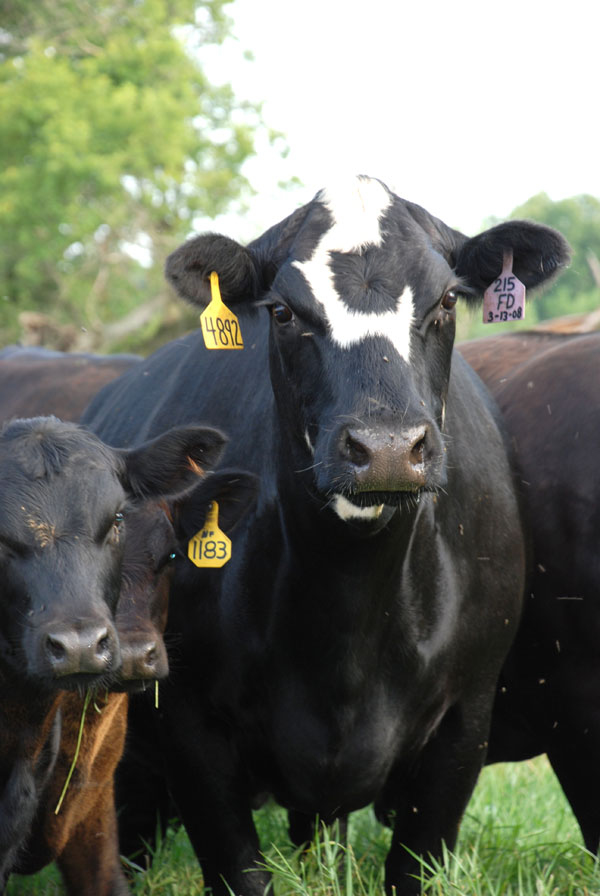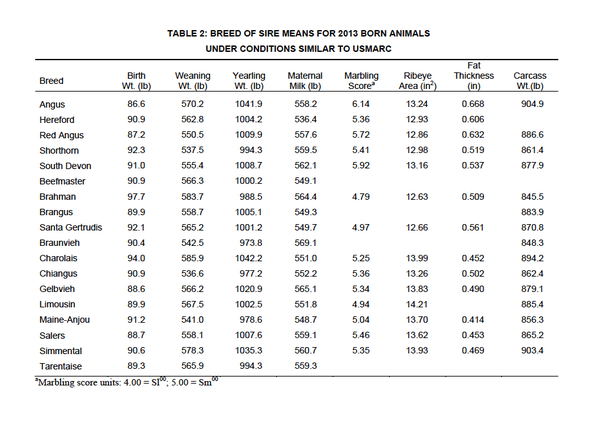Updated across-breed EPD tables now available.
June 25, 2015

When cattle producers first began to use expected progeny differences (EPDs) in their genetic decision-making, it was easy to compare bulls of the same breed. But because of the nature of EPDs, it was impossible to compare EPDs of bulls from different breeds.
That changed in 1993, when the U.S. Meat Animal Research Center (MARC) in Clay Center, Neb., first calculated across-breed adjustment factors for growth traits and maternal milk. Adjustment factors for carcass traits have been calculated since 2009 and this year, carcass weight was added for the first time; to be included, breeds must have carcass data in the MARC database and report their carcass EPDs on an actual carcass basis using an age-adjusted endpoint.
MARC released an updated table of adjustment factors used to estimate across-breed expected progeny differences (AB-EPDs) for 18 breeds at the Beef Improvement Federation annual meeting in Biloxi, Miss., earlier this month (Table 1). Bulls of different breeds can be compared on the same EPD scale by adding the appropriate adjustment factor to the EPDs produced in the most recent genetic evaluations for each of the 18 breeds.
 The AB-EPDs are most useful to commercial producers purchasing bulls of more than one breed to use in crossbreeding programs. For example, in terminal crossbreeding systems, AB-EPDs can be used to identify bulls in different breeds with high growth potential or favorable carcass characteristics.
The AB-EPDs are most useful to commercial producers purchasing bulls of more than one breed to use in crossbreeding programs. For example, in terminal crossbreeding systems, AB-EPDs can be used to identify bulls in different breeds with high growth potential or favorable carcass characteristics.
As an example, suppose a Red Angus bull has a weaning weight EPD of + 68.0 pounds and a Hereford bull has a weaning weight EPD of + 45.0 pounds. The across-breed adjustment factors for weaning weight (see Table 1) are –25.7 pounds for Red Angus and -4.4 pounds for Hereford. The AB-EPD is 68.0 – 25.7 = 42.3 pounds for the Red Angus bull and 45.0 - 4.4 = 40.6 pounds for the Hereford bull. The expected weaning weight difference when both are mated to cows of another breed (e.g., Angus) would be 42.3 pounds – 40.6 pounds = 1.7 pounds.
Most breed associations publish EPDs at least on an annual basis. These EPDs predict differences expected in performance of future progeny of two or more bulls within the same breed for traits including birth weight, weaning weight, yearling weight and maternal milking ability (as reflected in progeny weaning weights).
Normally, the EPDs of bulls from different breeds cannot be compared because most breed associations compute their EPDs in separate analyses and each breed has a different base point. The across-breed adjustment factors allow producers to compare the EPDs for animals from different breeds for these traits; these factors reflect both the current breed difference (for animals born in 2013) and differences in the breed base point. They should only be used with EPDs current as of June 2015 because of potential changes in EPD calculations from year to year.

BEEF Seedstock 100
Looking for a new seedstock provider? Use our BEEF Seedstock 100 listing to find the largest bull sellers in the U.S. Browse the Seedstock 100 list here.
It is important to note that the table factors (Table 1) do not represent a direct comparison among the different breeds because of base differences between the breeds. The factors should only be used to compare the EPDs (AB-EPDs) of animals in different breeds. To reduce confusion, breed of sire means (i.e., when sires from two different breeds are mated to cows of a third, unrelated breed) for animals born in 2013 under conditions similar to USMARC are presented in Table 2.
 The adjustment factors in Table 1 were updated using EPDs from the most recent national cattle evaluations conducted by each of the 18 breed associations (current as of March 2015). The breed differences used to calculate the factors are based on comparisons of progeny of sires from each of these breeds in the Germplasm Evaluation Program at MARC.
The adjustment factors in Table 1 were updated using EPDs from the most recent national cattle evaluations conducted by each of the 18 breed associations (current as of March 2015). The breed differences used to calculate the factors are based on comparisons of progeny of sires from each of these breeds in the Germplasm Evaluation Program at MARC.
Editor’s note—Larry Kuehn and Mark Thallman are geneticists at the U.S. Meat Animal Research Center. They can be reached at [email protected] or 402-762-4352 and [email protected] or 402-762-4261.
You might also like:
What's the least expensive way to breed cows? It might not be what you think
10 opportunities ahead for beef producers
Could 2015 be a profit repeat? Harlan's numbers suggest yes
7 tools to win the war against cattle flies
How to prevent & treat pinkeye in cattle
5 resources for choosing the best method to control noxious weeds
You May Also Like



